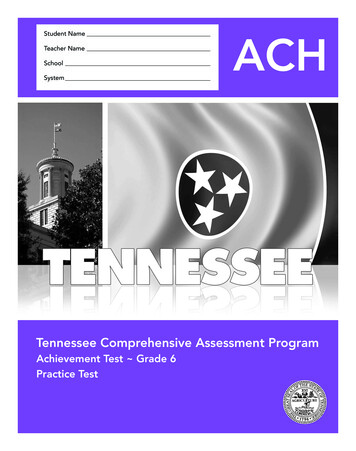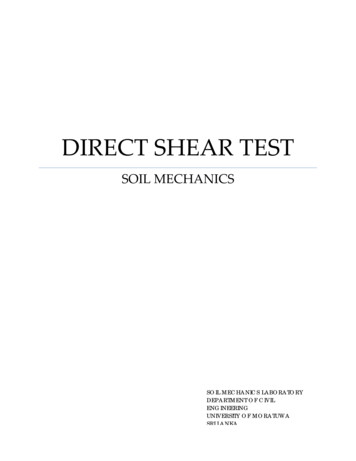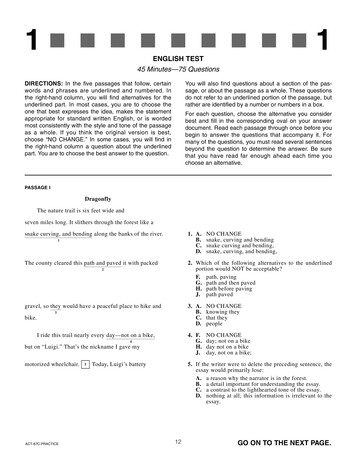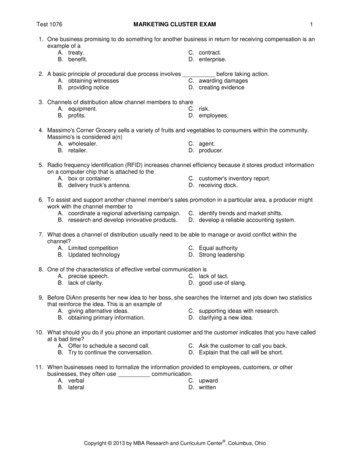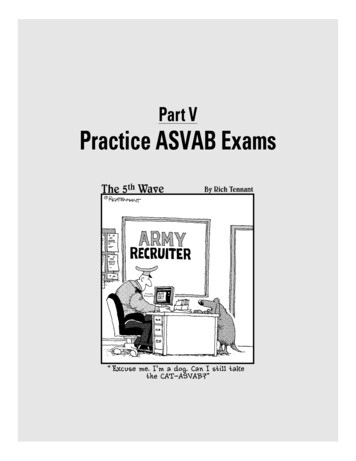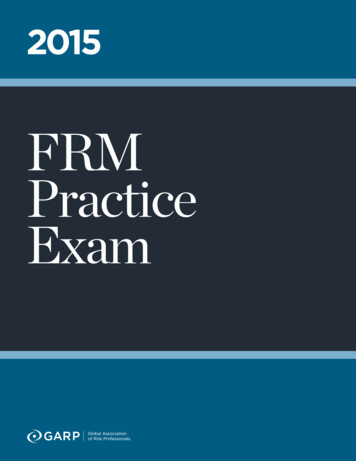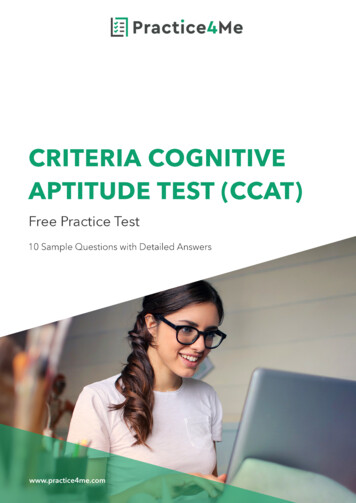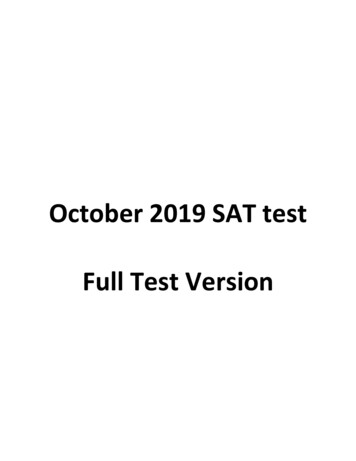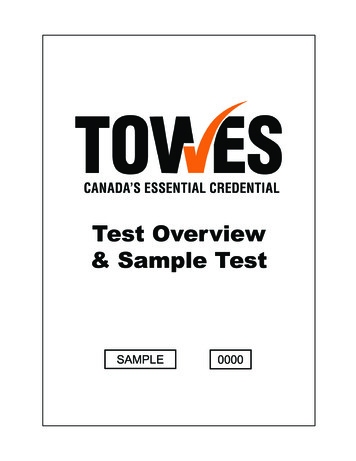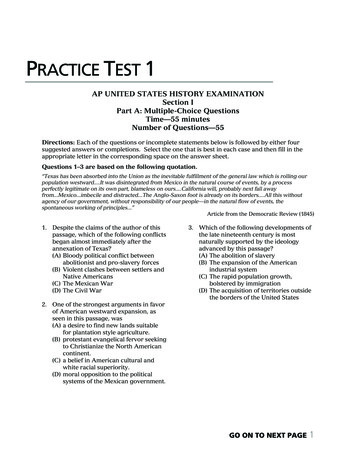
Transcription
PRACTICE TEST 1AP UNITED STATES HISTORY EXAMINATIONSection IPart A: Multiple-Choice QuestionsTime—55 minutesNumber of Questions—55Directions: Each of the questions or incomplete statements below is followed by either foursuggested answers or completions. Select the one that is best in each case and then fill in theappropriate letter in the corresponding space on the answer sheet.Questions 1–3 are based on the following quotation.“Texas has been absorbed into the Union as the inevitable fulfillment of the general law which is rolling ourpopulation westward.It was disintegrated from Mexico in the natural course of events, by a processperfectly legitimate on its own part, blameless on ours.California will, probably next fall awayfrom.Mexico.imbecile and distracted.The Anglo-Saxon foot is already on its borders.All this withoutagency of our government, without responsibility of our people—in the natural flow of events, thespontaneous working of principles.”Article from the Democratic Review (1845)1. Despite the claims of the author of thispassage, which of the following conflictsbegan almost immediately after theannexation of Texas?(A) Bloody political conflict betweenabolitionist and pro-slavery forces(B) Violent clashes between settlers andNative Americans(C) The Mexican War(D) The Civil War3. Which of the following developments ofthe late nineteenth century is mostnaturally supported by the ideologyadvanced by this passage?(A) The abolition of slavery(B) The expansion of the Americanindustrial system(C) The rapid population growth,bolstered by immigration(D) The acquisition of territories outsidethe borders of the United States2. One of the strongest arguments in favorof American westward expansion, asseen in this passage, was(A) a desire to find new lands suitablefor plantation style agriculture.(B) protestant evangelical fervor seekingto Christianize the North Americancontinent.(C) a belief in American cultural andwhite racial superiority.(D) moral opposition to the politicalsystems of the Mexican government.GO ON TO NEXT PAGE1
2N NPractice Test 1Questions 4–7 are based on the following quotation.“For the increase of shipping and encouragement of the navigation of this nation wherein be it enacted bythe king’s most excellent Majesty, and by the Lords and Commons in this present Parliamentassembled [that] no goods or commodities whatsoever shall be imported into or exported out of any lands,islands, plantations, or territories to his Majesty in any other ship but in such ships or vessels as do trulyand without fraud belong only to the people of England or Ireland and whereof the master and three fourthsof the mariners at least are English.”Navigation Act (1660)4. Which of the following best explains theintent of the act of Parliament excerptedabove and other similar acts of BritishParliament as created in the seventeenthcentury?(A) A desire to recoup financial lossesstemming from poorly organizedcolonial ventures(B) Fierce competition between theBritish and their growing colonialrivals in North America(C) An organized effort to restore loyaltyto the British crown among colonialinhabitants(D) Open contempt for the economicwell-being of the merchant class infavor of boosting the wealth ofproperty holders5. Which of the following best explains theresult of the enactment of laws like theone excerpted above?(A) A general disregard for the lawsamong colonists and a sense ofindifference on the part of the Britishgovernment(B) Rapid rise in the profitability of theBritish colonies from the perspectiveof the British monarchy(C) An increase in class and socialdivisions among British colonists,contributing to the significantdiversity present within the NorthAmerican colonies(D) Intensifying hostility betweenAmerican Indians and the Britishcolonists as the settlers sought toexpand their territorial control6. Which of the following concepts is bestrepresented by the content of the act inthe passage above?(A) Republicanism(B) Laissez-faire(C) Mercantilism(D) Constitutional democracy7. Which of the following developmentsmost significantly affected colonialreaction to laws such as the oneexcerpted in the passage above?(A) A history of self-governmenttogether with ideas of libertygleaned from the Enlightenment(B) A century of misrule by ineptcolonial governors(C) Declining trade values as the Britishturned their attention to othercolonies(D) Experiences along the frontier,which distinguished the colonistsfrom their British peers
Practice Test 1N N3Questions 8–11 refer to the following quotation.“Between 1500 and 1800, Western Europe experienced a historically unprecedented period of sustainedgrowth, perhaps the ’First Great Divergence,’ making this area substantially richer than Asia and EasternEurope by the beginning of the 19th century This pattern, at least in part, reflects the direct effects of’Atlantic trade’ between Europe and America Profits from Atlantic trade and colonialism strengthened newmerchant groups, and opened the way for changes in political institutions, which constrained expropriationby the monarchy and other established groups, encouraged commerce and production for the market, andenabled the emergence of new organizational forms and technologies.”Daron Acemoglu, Simon Johnson, and James Robinson,“The Rise Of Europe: Atlantic Trade, Institutional Change,And Economic Growth,” American Economic Review (2005, v95)8. Which of the following developmentsbest supports the authors’ claim that theAtlantic trade made Western Europe“substantially richer” beginning in thesixteenth century?(A) The rise of the African slave trade(B) The decimation of the indigenouspopulations of North and SouthAmerica(C) The importation of crops andresources from the New World(D) The growth of new systems ofventure finance9. Which of the following most stronglymotivated Western European powerslike the Spanish and Portuguese toinitiate the colonization of the NewWorld?(A) A desire to form settlements torelieve European populationpressure(B) Competition among rival nations forpower and prestige(C) Intense internal pressure from therising merchant class(D) Revolutionary zeal among politicalreformers10. Which of the following developmentsmade possible the economicdevelopments described in the passage?(A) Native resistance to Europeancolonization(B) The development of a belief in whitesuperiority(C) Improvements in maritimetechnology(D) Fragmentation of power amongEuropean monarchs11. As European colonization of the NewWorld progressed, the most significantethical debate surfaced over the issue of(A) the desirability of allowing long-termagricultural colonies.(B) prohibiting the importation of slavesinto New World settlements.(C) opening trade with competingcolonial powers.(D) the treatment of the NativeAmericans whom explorersencountered in the New World.GO ON TO NEXT PAGE
4N NPractice Test 1Questions 12–15 are based on the following graph.Source: U.S. Bureau of the Census, pov2.html12. Which of the following programs wasmost clearly focused on reducing theproblems that resulted from the trend inthe graph above?(A) The Great Society(B) The policy of containment(C) The Republican resurgence of the1980s(D) The civil rights movement13. The federal response to data representedby this graph fueled which of thefollowing national conflicts?(A) Clashes between the executive andlegislative branches(B) Renewed attempts to restrictimmigration(C) Questions over the proper scope ofnational authority(D) Generational tensions made worseby partisan politics14. Which of the following contributed tothe increase in the number of Americansliving in poverty after 1980?(A) A sharp drop in the number ofemployed women(B) The growth of low-payingmanufacturing jobs(C) The decline in the influence of unions(D) The elimination of many New Deal–era social programs15. Questions about income inequality inAmerica from 1960 to 2008 reviveddebates about(A) the legacy of racial discrimination inthe United States.(B) the nature of the American Dream.(C) the protection of civil liberties.(D) the government’s role as a center ofnational morality.
Practice Test 1N N5Questions 16–19 are based on the following quotation.“We hold these truths to be self-evident, that all men are created equal, that they are endowed by theirCreator with certain unalienable Rights, that among these are Life, Liberty and the pursuit of Happiness.—That to secure these rights, Governments are instituted among Men, deriving their just powers from theconsent of the governed, —That whenever any Form of Government becomes destructive of these ends, it isthe Right of the People to alter or to abolish it, and to institute new Government, laying its foundation on suchprinciples and organizing its powers in such form, as to them shall seem most likely to effect their Safety andHappiness.”Thomas Jefferson, Declaration of Independence (1776)16. Which of the following developmentsmost strongly prompted the colonists toexpress the sentiments in the passage?(A) Frustration over the failure of theBritish Crown to protect thecolonists’ property from theexpansionary tactics of the French(B) British efforts to dissolve colonialcharters as the Crown attempted toconsolidate its political power(C) A growing cultural divide betweenthe colonists and the British, leadingto an almost total lack of commonground despite a common heritage(D) Attempts by the British toreinvigorate the mercantilist systemof trade to the detriment of colonialeconomic growth17. In what way did the Enlightenmentinfluence the colonists as they unitedunder the ideology expressed in thispassage?(A) It emphasized the value of theindividual and proclaimed thedoctrine of natural rights.(B) It united the colonists under a senseof entitlement as a people uniquelyblessed by Divine Providence.(C) It rejected the legitimacy of anygovernment based in heredity infavor of direct democratic rule.(D) It introduced for the first time theconcept of limited government andself-rule.18. Despite declaring their commitment tothe ideas of the Declaration ofIndependence as illustrated in thepassage, debate continued into thenineteenth century over(A) the legitimacy of any governmentborn in revolution.(B) the extent to which the new nationwas willing to grant liberty andequality to all.(C) the role of economic liberty in arepublic founded upon the ideals ofegalitarianism.(D) the wisdom of the republican systemas the government attempted tosecure stability for the new nation.19. Which of the following developments ofthe early American republic mostdirectly contradicted the philosophyadvanced by the passage?(A) The gradual reduction of propertyqualifications for voting(B) The continued disenfranchisement ofblack and female Americans(C) The open debate between advocatesof limited government and advocatesof a strong federal system(D) The repeated attempts by thenational government to secure theeconomic growth of the nationGO ON TO NEXT PAGE
6N NPractice Test 1Questions 20–23 are based on the following quotation.“New Deal policy-makers were beginning to address the needs of blacks. The Public Works Administration,for example, mandated the proviso: ‘There shall be no discrimination on account of race, creed or color.’Blacks praised the WPA for prohibiting racial discrimination and for giving them a chance to participate in theprogram The Democratic Party’s strategy paid off. The massive migration of blacks to northern cities hadled to a national political realignment.”Ronald Takaki, A Different Mirror (1993)20. Which of the following best explains themigration of blacks referenced in thispassage?(A) Widespread discrimination in theSouth, forcing many blacks to flee(B) Long years of drought, challengingthe viability of agriculture in theSouth(C) Growth in available jobs due to therise in the industrial economy(D) An end to segregation in majorNorthern cities, attracting those whosought a new start21. What would be the political impact ofthe realignment that Takaki describes?(A) The Democratic Party’s liberalizationand willingness to push ever moreextensive reforms(B) A shift in the balance of power in theHouse of Representatives, due tosignificant apportionment changes(C) A series of increasingly favorableSupreme Court decisions throughoutthe 1930s and 1940s(D) The decline in the impact ofindustrial interest groups in the faceof campaigns that reached out to theworking class22. Which of the following best describesthe philosophical shift embodied by theactions of the Democratic Partydescribed in the passage?(A) A turn from laissez-faire policies andtoward political support for securityfor all citizens(B) A renewed effort to limit the powerof industrial and political elites(C) An intense commitment to the ideasof racial and social equality(D) An abandonment of the traditionalpolitical coalitions that had been inplace since the 1870s23. The efforts of the Democratic Partydescribed in the passage would be morefully realized through the programs of(A) Woodrow Wilson(B) Franklin D. Roosevelt(C) Lyndon B. Johnson(D) Ronald ReaganQuestions 24–25 refer to the following quotation.“After the shock of September 11, Americans rallied around the flag in support of their country and theirgovernment. Unfortunately, that commendable sentiment brought a blind loyalty, an unquestioningwillingness to accept whatever the leadership said was necessary to fight terrorism Far from [maintainingthis unity] in efforts to defend our country, the Bush administration has divided the nation by contorted legaldoctrines that seek to allow searches without prior judicial review [and that] deny American citizens theirconstitutional rights.”Richard A. Clarke, Against All Enemies: Inside America’s War on Terror (2004)24. The ideas expressed in the passage mostdirectly reflect which of the followingcontinuities in United States history?(A) Debates about the balance betweencivil liberties and national security(B) Debates about America’s role in theinternational community(C) Debates about the proper extent offederal authority(D) Debates about American treatmentof minorities and immigrants
Practice Test 1N N725. Which of the following foreign policyinitiatives was intended to fightterrorism in the wake of September 11?(A) The liberation of Kuwait(B) The invasion of Afghanistan(C) The use of sanctions againstdictators in North Africa and theMiddle East(D) The opening of diplomatic talksbetween Israel and EgyptQuestions 26–28 are based on the following map.26. Based on the movement of thecolonial frontier in the eighteenthcentury and the information inthe map, which of the followingconclusions can best be drawn?(A) The British government hadno interest in expandingbeyond the coastal territoriesthey had originally colonized.(B) The presence of the Frenchas colonial rivals limited theability of the British to claimthe territory inland of theAppalachian Mountains.(C) The colonists’ expansionismwould result in an increase incostly clashes with NativeAmericans.(D) Fur trading and trappingwould soon outpace theeconomic value of cash cropsfor the British colonies inNorth America. Cengage Learning.27. After American independence wasachieved, the continuation of thesettlement trends illustrated by this mapresulted in(A) the development of a homogenous,national culture.(B) reduced conflicts between settlersand Native Americans.(C) isolation from conflict withEuropean powers.(D) an increase in support for acentralized government.28. Which of the following developmentsprompted the British to prohibit colonialexpansion beyond the Proclamation Lineof 1763?(A) Continued conflict betweenAmerican colonists and Frenchsettlers(B) A series of Native Americanuprisings that destabilized thefrontier(C) British inability to effectively governthe inland areas of the continent(D) Threats by the Spanish againstwestward-moving colonistsGO ON TO NEXT PAGE
8N NPractice Test 1Questions 29–34 are based on the following quotation.“In the years from the Civil War to the end of the nineteenth century, bold new men of industry, primitive inmorals but mature in the techniques of exploitation, remade the United States both physically and socially. But at the same time the ravages of industry were painfully evident The heterogeneous millions ofimmigrants who streamed in to fill the need for a new labor force were not welcomed by the nativepopulation and often found only the most dismal living conditions The farmer, especially in the West andSouth, was finding himself at an increasing disadvantage in the economy At the close of the century, with reform defeated and conservatives in firm control of all three divisions of the federal government, few mencould have foreseen the immense burst of successful reform which was to come.”Richard Hofstadter, “Industrialism and Social Reform,”Great Issues in American History (1969)29. Which of the following developmentsmost directly contributed to theeconomic conditions described in thepassage?(A) The growth of the middle class(B) The closing of the American frontierin 1890(C) The rapid advances in technologyand systems of finance(D) The rise of popular democraticmovements30. Which of the following ideologies wouldmost strongly have justified the starkcontrasts described in the passage?(A) Social Darwinism(B) Nativism(C) Populism(D) The Americanization movement31. Which of the following most accuratelycharacterizes the responses ofAmericans to the rise of industrialismand the changes that accompanied it?(A) Farmers actively resisted themechanization of their labor(B) Political machines developed toadvance the interests of theindustrial powerhouses(C) Legislators interested in re-electionstrongly opposed any attempts bythe government to favor industry(D) Workers’ unions organized toconfront corporate power anddemand better conditions32. By what methods did industrial leadersconsolidate their power in the secondhalf of the nineteenth century?(A) Elimination of competition andconsolidating control over bothresource and labor markets(B) Avoidance of political entanglementsin favor of operating exclusively inthe realm of finance(C) Negotiation with labor organizationsto avoid the inefficiencies of strikesand unrest(D) Reliance upon a large body of skilledlaborers to produce higher qualityproducts33. What impact would the industrialgrowth described in the passage haveupon the geography and demography ofthe United States?(A) A decline in the population of the oldNortheast in favor of the rapidlygrowing Midwest(B) Significantly acceleratedurbanization, led by rapidly growingnumbers of immigrants(C) Rapid population growth in the“New South,” supported by theconstruction of new factories(D) A slowing of westward migration asopportunities in the east presented achance at wealth for people of allstations34. Which of the following movementswould ultimately achieve the “successfulreforms” that followed on the heels ofthe industrial era as described by thepassage?(A) Populism(B) Progressivism(C) Nativism(D) Conservationism
Practtice Test 1NN N9Questionns 35–36 reffer to the foollowing quootation.“When it shallsplease God to send you on the coast of Virginia, yyou shall do yyour best endeeavour to find out asafe port in the entrancee of some navvigable river, makingmchoicee of such a onee as runneth fafarthest into thheland Forr if you sit dowwn near the enntrance an ennemy that mayy approach yoou on even groound, may eassilypull you out; In all yoour passages youy must havee great care noot to offend thhe naturals [naatives], if you ccaneschew it; and imploy some few of yoour company tot trade with tthem for cornn You shall dod well to sennd a perfect relation by Capttaine Newporrt of all that is done and too suffer no mann toreturn butt by pasport frrom the Presiddent and Counnsel, nor to wrrite any letter of anything thhat may discouurageothers.”Instructionns for the Virgginia Colony (1606)35. Whicch of the folloowing charaacteristics offearly English coloonization is bestbdescrribed in the passagepaboove?(A) GenerallyGloww desire on thhe part ofEnglish citizeens to settle thet NewWorldWin largge numbers(B) Struggles to identifyia siggnificantlaabor source tot support anaaggricultural colonialceconnomy(C) Failure to seccure the suppport of theCrownCfor exxploratory veentures,reesulting in ecconomic ruinn(D) Particularly hostilehrelatioons with theAmericanAInddians encounntered byseettlers36. UUnlike the BBritish settlerrs, the Spaniishaand French colonists tennded to((A) intermarrry with the native peopllethey enccountered.((B) avoid ovver-reliance oon an exporttbased ecconomy withhin their coloonies.((C) focus heavily on idenntifying andmining mmineral resources.((D) operate iin relative inndependencee oftheir respective monnarchicalgovernmments.Questionns 37–40 aree based on thetfollowinng cartoon.Widespreadd support forr this cartoonnist’s37. Wvviewpoint abbout Reconsstruction mostddirectly led ttodrawal of federal troopss((A) the withdfrom thee South followwing stronggDemocraatic oppositiion toReconstrruction.((B) the creattion of the Freedman’sBureau aand other aggencies intenndedto protecct the rights of former sllaves.((C) the ratifiication of thee FourteenthhAmendmment as a meeasure to prootectthe rightts of American citizens.((D) the soliddification of tthe system oofsharecroopping as a mmeans ofcontrolliing Southernn labor probblems.GO ON TTO NEXT PAAGE
10N NPractice Test 138. Which of the following graduallyweakened the “strong government”pictured in the cartoon in the yearsleading up to the 1876 election?(A) The incompetency of most SouthernRepublican legislators(B) A decline in the political will of theNorth to continue to enforceReconstruction governments(C) Persistent violence on the part ofSouthern landowners against formerslaves(D) Widespread resistance encounteredin attempting to ratify the ThirteenthAmendment39. Which of the following groups wouldmost clearly have supported thiscartoonist’s opinion on grantsDemocrats40. This cartoon most strongly challengesthe idea that(A) the national government has theauthority to intervene in regionalaffairs.(B) the role of violence can belegitimized in protecting economicinterests.(C) foreign affairs naturally influence thepolicies of an ambitious nation.(D) the needs of the general populationoutweigh the interests of a minoritygroup.Questions 41–45 refer to the following quotation.“The very existence of the Greek state is today threatened by the terrorist activities of several thousand armedmen, led by Communists, who defy the government's authority at a number of points, particularly along thenorthern boundaries Meanwhile, the Greek Government is unable to cope with the situation . I believe thatit must be the policy of the United States to support free peoples who are resisting attempted subjugation byarmed minorities or by outside pressures . The free peoples of the world look to us for support inmaintaining their freedoms. If we falter in our leadership, we may endanger the peace of the world. And weshall surely endanger the welfare of this nation.”Harry Truman, Speech before a Joint Session of Congress(March 12, 1947)41. Which of the following best summarizesthe foreign policy objective of the UnitedStates, as stated here by PresidentTruman?(A) To commit superior military force toliberate the Communist-dominatedareas of Eastern Europe(B) To use the nation’s economic capitalto secure resources and markets forgenerations to come(C) To maintain a position of power inthe Mediterranean as a check on thegrowth of new dictatorial regimes(D) To stop the spread of Communistmilitary power and ideologicalinfluence42. Which of the following best explains thereason for President Truman’scommitment to the policy he describes inthe passage?(A) A desire to expand Americanterritorial holdings whilediscouraging further colonization byEuropean powers(B) The necessity of free markets forAmerican goods along with fears ofa world dominated by totalitarianism(C) An overwhelming commitment tothe spread of democracy across allnations in the world(D) Unwillingness on the part of theAmerican public to commit UnitedStates resources to anotherinternational conflict
Practice Test 1N N1143. What was the result of the UnitedStates’s adherence to the policiesprescribed by President Truman in thispassage?(A) The avoidance of armed conflict forthe two decades following WorldWar II(B) The growth of the United States’smilitary-industrial complex(C) A decline in the significance ofinternational coalitions(D) A relaxation in trade barriers amongnations throughout the world44. Domestically, what was the impact onthe United States of the policy describedin the passage?(A) A more open, tolerant societycommitted to the ideals of liberty,individuality, and democracy(B) A reduction in political participation,given the new focus of the nationalgovernment on foreign policy(C) A gradual economic decline, broughton by low consumer confidenceamid uncertain times(D) The rapid growth of consumertechnology, spurred on by advancesin military and scientific capabilities45. Which of the following events is mostdirectly related to the policy declarationmade in the passage?(A) The Korean conflict of the 1950s(B) The desegregation efforts of the1960s(C) The oil shocks of the 1970s(D) The Middle East conflicts of the1980sQuestions 46–50 are based on the following quotation.“It is Marshall who is praised for clearly establishing the supremacy of the federal government and fordrawing well-defined lines around state power. And although the Justice lived in a day when the nationalgovernment had little interest in directly exerting its own power, he is credited with having staked out for itsuch broad areas of permissible authority that when federal agencies did wish to move the way was openwithout legal obstacles Marshall’s view of political nationalism and his interpretation of judicial authorityconveniently harmonized with his economic outlook. Rampant localism and its threat of “dismemberment”had economic implications which Marshall found dangerous.”Paul L. Murphy, “The Marshall Court and American Nationalism,”Main Problems in American History (1964)46. Which of the following trends in therulings of the Supreme Court of theearly American republic most closelydemonstrates the ideas expressed in thepassage?(A) Increased recognition for the rightsof property holders(B) Commitment to the development ofthe nation’s commercial interests(C) The assertion of federal power overstate laws(D) Hostility to the attempts ofabolitionists to defy Constitutionalprotections of slavery47. Which of the following political partiesof the late eighteenth and earlynineteenth centuries would moststrongly have agreed with the actions ofChief Justice John Marshall, asdescribed in the passage?(A) The Federalists(B) The Democratic-Republicans(C) The Democrats(D) The Know-Nothing Party48. Which of the following debates rose outof a significant challenge to the ideologyof the Marshall Court as expressed inthis passage?(A) Controversy over Indian policy onthe western frontier(B) Southern opposition to theenactment of protective tariffs(C) Elite fears of “mob-ocracy” and thegrowth in power of the unpropertied classes(D) Insistence by Second GreatAwakening reformers on theextension of rights to women andminoritiesGO ON TO NEXT PAGE
12N NPPractice Test 149. Considering the positionpof JohnJMarsshall, as desccribed in the passage,whichh of the folloowing eventss would hemost strongly havve opposed?(A) The rise of the American System(B) The Louisianaa Purchase(C) The Missouri Compromisse(D) The attempted defeat of thhe nationalbank50. WWhich of thee following ttwentiethccentury movvements owees the most tto theiideology of JJohn Marshaall as describbediin the passagge?((A) The expaansion of ecoonomic andsocial prrograms of thhe 1960s((B) The growwth of enviroonmentalprotectioonism in the 1970s((C) The resuurgence of coonservatism inthe 1980s((D) The reduuction in soccial welfareprogramms initiated inn the 1990sQuestionns 51–55 aree based on thetfollowinng image.51. The performersppicturedpheree most likelyy(A) exxperienced littlelracism as the jazzagge melted prrejudices in thet UnitedStates.(B) seerved to builld support foor theAmericanAeffoorts in Worlld War I.(C) benefited fromm the changges broughtbyy urbanization and warttimemigrations.m(D) oppenly oppossed the reforrm efforts ofthhe Democrattic Party.52. Whicch of the folloowing contrributed mosttto thee growing poopularity of jazzjbandssuch as this one?(A) The surge in immigrationin in theyeears followinng World WarW I((B) The end to Prohibitioon and thereinvigoration of jazzz clubs in NeewYork Cityy and other urban areass((C) Significaant successes achieved bbyunions, rresulting in iincreased leiisuretime((D) Modern technologiees and betterrcommunnication systeems, whichhelped bbuild a nationnal culturalrevival53. WWhich of thee following mmovements bbestccharacterizees the image pictured herre?((A) Harlem RRenaissancee((B) Great MMigration((C) Scientificc Modernismm((D) Progresssivism
Practice Test 1N N1354. Which of the following best describesthe long-term impact of the popularity ofbands such as this one?(A) The success of musicians like thesebolstered the efforts offundamentalist groups in reshapingthe American culture.(B) Southern outrage at the idea ofmixed-race entertainment venuesresulted in a strengthening ofsegregationist policies across theUnited States.(C) The acceptance of jazz led to aflowering of cultural expressionacross the African Americancommunity and to the developmentof a sense of racial pride andidentity.(D) The experimental nature of jazzencouraged other forms ofexperimentation, especially amongveterans of World War
(A) a desire to find new lands suitable for plantation style agriculture. (B) protestant evangelical fervor seeking to Christianize the North American continent. (C) a belief in American cultural and white racial superiority. (D) moral opposition to the political systems of the Mexi
